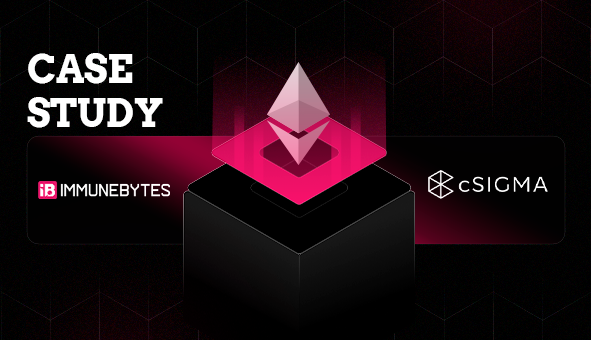Background
cSigma Finance is a decentralized lending protocol, designed to seamlessly connect global borrowers and lenders. By leveraging AI, the protocol optimizes critical aspects of the lending process, including credit rating, pricing, and risk management. It facilitates secure capital movements, on-chain accounting, and settlement, while allowing third-party underwriters and risk assessors to contribute to the protocol’s ecosystem.
Vision and Mission
cSigma Finance aims to revolutionize private credit by offering a transparent, efficient, and decentralized lending platform. It empowers credit pool operators to originate loans securely and transparently while supporting efficient fund flows and role-based access control. Leveraging the ERC-2535 Diamond Proxy standard, the protocol ensures scalability, upgradability, and seamless maintenance.
Aim
The primary aim of this audit was to ensure that the smart contracts powering cSigma Finance are secure, reliable, and function according to their intended design. The audit focused on identifying potential vulnerabilities, assessing architectural integrity, and ensuring the correctness and maintainability of the codebase. Additionally, the audit sought to validate the protocol’s access control mechanisms, transaction flows, and alignment with best practices in smart contract development.
Client Expectations
The cSigma Finance team approached the audit with clear expectations. They wanted a comprehensive review of their smart contract architecture, with a focus on identifying security vulnerabilities, ensuring code correctness, and verifying adherence to Solidity best practices. They also emphasized the importance of a thorough assessment of their role-based access control system, validation of fund flows, and detection of any potential risks related to protocol upgrades.
What We Did
The audit process began with an in-depth analysis of the smart contracts’ architecture, focusing on their adherence to the ERC-2535 Diamond Proxy standard. We conducted a thorough manual code review, analyzing the code line-by-line to uncover subtle bugs and logical inconsistencies that automated tools might overlook. Additionally, we performed threat modeling, mapping potential attack vectors and prioritizing vulnerabilities based on their severity and impact.
Key Features of cSigma Finance:
cSigma Finance introduces several innovative features to enhance decentralized lending and borrowing:
-
- Decentralized Lending and Borrowing: Secure and trustless connections between global lenders and borrowers without intermediaries.
- AI-Driven Risk Management: In-built mechanisms for credit rating, pricing, and risk assessment.
- On-Chain Fund Management: Transparent and traceable fund flows between lenders, credit pools, and pool managers.
- Role-Based Access Control: Granular access management ensures only authorized actors can perform critical functions.
- Diamond Proxy Architecture: Modularity and upgradability through the ERC-2535 standard.
Audit Focus
The primary objective of this audit was to ensure that the smart contract system is secure, resilient, and functions precisely as intended. The audit process was structured into three key areas:
-
- Security: Identifying vulnerabilities like reentrancy, unchecked external calls, and access control flaws across the contracts.
- Architectural Soundness: Evaluating the system’s architecture against industry-standard smart contract practices, ensuring robustness and scalability.
- Code Quality and Correctness: Verifying code clarity, maintainability, logical soundness, and adequate testing coverage.
This structured approach ensured that cSigma Finance adheres to best practices in security, design, and code quality.
Audit Insights
ImmuneBytes conducted an in-depth audit of cSigma Finance, during which three key issues of Low Severity and Informational nature were identified. No Critical, High, or Medium Severity vulnerabilities were discovered. The team demonstrated responsiveness by acknowledging all identified issues and providing detailed clarifications.
We have split the issues according to the severity levels:
-
- High severity issues will bring problems and should be fixed.
- Medium severity issues could potentially bring problems and should eventually be fixed.
- Low severity issues are minor details and warnings that can remain unfixed but would be better fixed at some point in the future.
| ID | Findings | Severity | Description | Status |
|---|---|---|---|---|
| 1 | Inflexible Domain Separator Setting | Low | Hardcoded values limit dynamic updates to domain separator. | Acknowledged |
| 2 | Missing Input Validation | Low | Functions lack proper validation for critical inputs. | Acknowledged |
| 3 | Insufficient Event Emission in Functions | Info | Key functions lack event emissions for traceability. | Acknowledged |
Key Findings
-
-
Inflexible Domain Separator Setting Mechanism
Description: The Inflexible Domain Separator Setting Mechanism in the setDomainSeparator() function relied on hardcoded values, limiting flexibility for future updates and requiring redeployment for changes. Auditors recommended enabling dynamic updates via input parameters. The cSigma team acknowledged this but stated the static design ensures consistency across deployments.
Impact: Maintenance challenges and reduced adaptability to evolving requirements.
-
Missing Input Validation
Description: The Missing Input Validation issue affected setMinDepositLimit in the VaultFacet and updatePoolManagerWallet in the PoolManagerFacet, lacking checks for valid ranges and non-zero addresses. Auditors recommended adding validation checks. The cSigma team acknowledged this but noted restricted access minimizes risks and emphasizes gas efficiency as a trade-off.
Impact: Potential risks of logical errors, security vulnerabilities, and unintended states.
-
Insufficient Events Emission
Description: The Insufficient Events Emission in Critical Functions issue affected facets like AccessControlFacet, CreditPoolFacet, and VaultFacet, reducing transparency and hindering off-chain monitoring. Auditors recommended adding event emissions for better traceability. The cSigma team acknowledged this but noted that many functions are rarely called and existing events are sufficient for monitoring.
Impact: Limited auditability, reduced transparency, and difficulty in monitoring contract operations.
-
Conclusion
The audit of cSigma Finance confirmed adherence to best practices in security, architecture, and code quality, with no critical, high, or medium-severity issues detected. Low-severity findings were acknowledged with clear reasoning from the team. This reflects cSigma Finance’s commitment to building a secure and reliable decentralized lending protocol.
This audit highlights cSigma Finance’s strong commitment to maintaining a secure and transparent decentralized lending protocol. The proactive measures taken to address audit recommendations reinforce the protocol’s credibility and readiness for secure on-chain financial operations.
